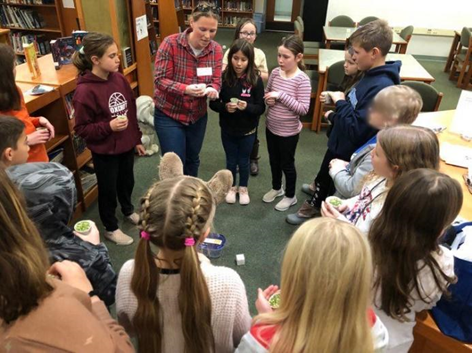
The Nature Conservancy brings river restoration opportunities to Piscataquis County
The Piscataquis County Soil & Water Conservation District is excited to announce they are entering into a three-year contract with the Maine Chapter of The Nature Conservancy that focuses on implementation of stream restoration and aquatic organism passage projects. The work will be administered through the Watershed-scale Approach to Restoring Stream Systems, a program developed to restore aquatic organism passage to road-stream crossings on private lands funded through the Regional Conservation Partnership Program with the USDA Natural Resources Conservation Services.
WATRSS is a five-year, almost $7 million dollar program that provides significant financial aid and technical assistance to private landowners to help them upgrade road-stream crossings. TNC is the lead partner organization for the project.

TROUT LIFE CYCLE — PCSWCD Education Coordinator Kacey Weber teaches students at SeDoMoCha Elementary in Dover-Foxcroft about the life cycle of trout.
The project improves road safety and stability while increasing opportunities for fish and other aquatic life to thrive. WATRSS is supported by a collaboration of nine tribal, state, federal, and nonprofit organizations (such as PCSWCD) and covers 25,255 square miles of project area, including the last endangered Atlantic Salmon spawning waters in the U.S. and critical Eastern brook trout habitat. Landowners are eligible for financial and technical assistance to implement aquatic organism passage projects that improve fish habitat and stream connectivity while strengthening roadway infrastructure and the forest economy.
Over the last two years, PCSWCD has been working with TNC and the RCPP program to improve and enhance fishway and aquatic organism passages in Piscataquis County. TNC in Maine is dedicated to restoring connected river systems for the state’s twelve sea-run fish species and wild native brook trout. TNC has a long history of collaborating with private forest landowners and municipalities throughout Maine to implement river restoration projects that allow these species to thrive while providing climate-ready road crossings designed to stand up to increased flooding. To date, with help from TNC, PCSWCD has completed 30 projects in Piscataquis County in partnership with NRCS and local landowners, opening 37 total stream miles to fish passage.
In addition to the WATRSS contract, TNC awarded PCSWCD another private award for the next two years! This will provide capacity support to PCSWCD to enable an increased focus on stream and river connectivity, restoration activities, and educational events and opportunities for youth and adults related to aquatic ecosystem health and stream restoration.
One project PCSWD has already gotten underway is implementing Trout in the Classroom, with SeDoMoCha Elementary School’s fourth grade library class. This project was funded through the partnership with TNC and allows PCSWCD’s Education Coordinator Kacey Weber to connect students with their local watersheds. Students will learn to see connections between the trout, water resources, the environment, and themselves while studying and raising trout from eggs to fingerlings (small fish). PCSWCD will be setting up a cold-water aquarium after Christmas vacation and 300 trout eggs will arrive at the beginning of February. In the spring, the program culminates with a field trip to Browns Mills Park, in Dover-Foxcroft, where students will release their fish into the state-approved location, the Piscataquis River.
“It’s so exciting to bring Trout in the Classroom to our local school and we are thrilled to partner with SeDoMoCha Elementary to offer this unique opportunity for children in our community,” said Sarah Robinson, PCSWCD executive director.
PCSWCD will be offering several workshops and outreach opportunities in the coming year with the focus on Stream Smart and aquatic organism restoration. For more information on these services, visit www.piscataquisswcd.org or follow PCSWCD on Facebook to stay up to date with the projects.
This project was made possible through support provided by the Natural Resources Conservation Service (NRCS) and The Nature Conservancy (TNC), under the terms of the RCPP Agreement Supplemental- 2306-A-0437. The content and opinions expressed herein are those of the authors and do not necessarily reflect the position or the policy of such agency or The Nature Conservancy, and no official endorsement should be inferred. Any opinions, findings, conclusions, or recommendations expressed in this publication are those of the author(s) and do not necessarily reflect the views of the U.S. Department of Agriculture. In addition, any reference to specific brands or types of products or services does not constitute or imply an endorsement by the U.S. Department of Agriculture for those products or services.